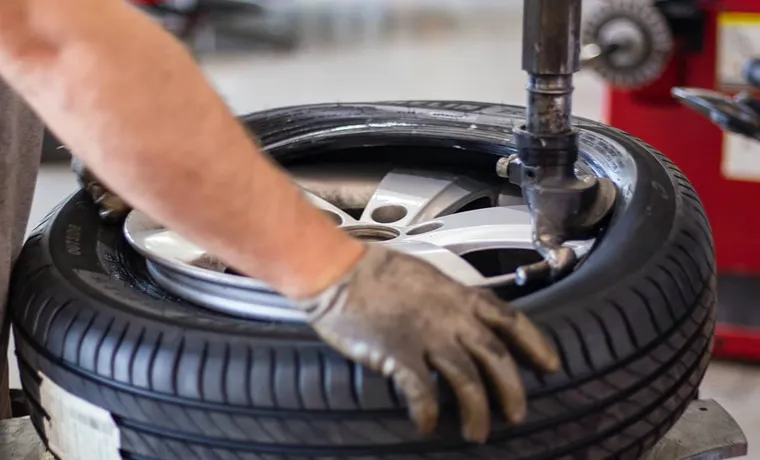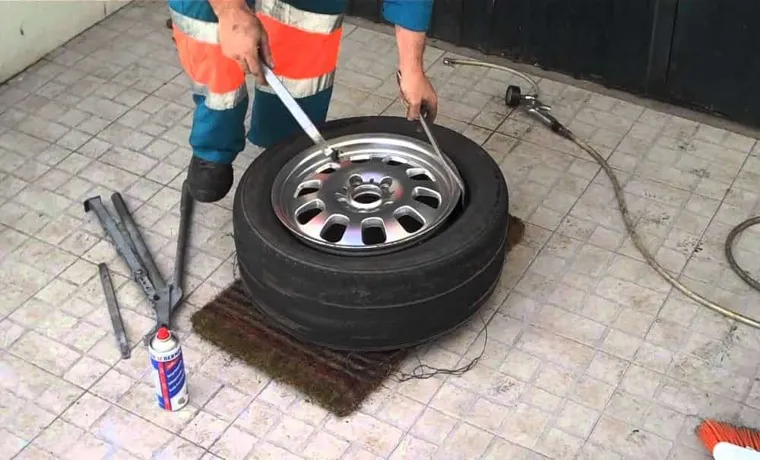Putting a new tire on a rim may seem intimidating, especially if you have never done it before. However, with the right tools and knowledge, you can easily take on this task and have your vehicle back on the road in no time. In this blog post, we will guide you through the process of putting a new tire on a rim step-by-step.
From removing the old tire to installing the new one, we’ve got you covered! So, if you have a flat tire or want to replace your old tires, keep reading to learn how to put a new tire on a rim like a pro.
Table of Contents
Assessing the conditions of the tire and the rim
When it comes to putting a new tire on a rim, it’s important to assess the conditions of both before proceeding. First, check for any signs of damage or wear on the tire itself, such as cracks, bulges, or punctures. If the tire looks to be in good shape, move on to the rim.
Look for any dents, bends, or corrosion that may affect the tire’s ability to properly seal and hold air pressure. It’s also crucial to ensure that the rim is the correct size and type for the tire being installed. Matching the wrong tire to the wrong rim can lead to a variety of problems, such as increased wear and tear or decreased stability.
By taking the time to assess both the tire and the rim beforehand, you can ensure a safe and successful tire replacement.
Check for cuts, punctures or bulges on the tire
When it comes to assessing the conditions of your tire and rim, it’s crucial to keep an eye out for cuts, punctures, or bulges on the tire. These issues can lead to serious problems while driving, such as a spontaneous blowout or a flat tire. It’s important to examine your tires frequently, especially if you’re using them frequently or if the weather conditions are rough.
If you notice any cuts that are more than 1/4 inch long, punctures that are deep enough to expose the fabric, or bulges that look odd, it’s best to have them checked out by a professional as soon as possible. As well, checking for tire pressure is essential to make sure your tires can function ideally. The last thing you want is to suddenly have an issue while on the road.
Remember, assessing the condition of your tire and rim will help keep you and your car safe, and save you from any unforeseen accidents.

Inspect the rim for dents, scratches or signs of wear
When it comes to assessing the conditions of your tire and rim, it’s important to take a close look at both. Inspecting the rim for dents, scratches or signs of wear is a crucial step in ensuring your tire stays in good shape. A damaged rim can lead to uneven wear on your tire and, in severe cases, a blowout.
Give the rim a thorough once-over, looking for any signs of damage that could compromise its integrity. If you do notice any dents or scratches, it’s essential to have a professional take a closer look. They can assess the extent of the damage and advise you on the next steps to take.
Remember, a healthy rim means a healthier tire, so don’t neglect this vital step in tire maintenance.
Removing the old tire
When it comes to changing a tire on a rim, the first step is always to remove the old tire. This can be done using a tire iron and a bit of elbow grease. Start by loosening the lug nuts on the tire using the tire iron.
Once they are slightly loose, you can use a jack to lift the vehicle off the ground. Make sure to place the jack in a safe spot on the car’s frame, as outlined in your owner’s manual. Once the car is lifted, finish unscrewing the lug nuts and remove them from the wheel.
Gently pull the tire off the rim, taking care not to damage the rim in any way. It’s a good idea to inspect the rim for any damage or wear while you have the tire off. Once the old tire is removed, you can begin the process of putting on a new tire.
Use a tire iron to remove the lug nuts
When it comes to changing a tire, the first step is to remove the old one. To do so, you’ll need to use a tire iron to remove the lug nuts. This tool is typically included in most car’s emergency kit, and it’s easy to use.
However, if you don’t have a tire iron, a socket wrench or tire removal kit would also work. Begin by parking your car on a level surface and engaging the parking brake. Then, using the tire iron, turn the lug nuts counterclockwise until they loosen.
You may need to use some force or step on the wrench to break the nuts free. Once they’re loose, remove them from the wheel studs and set them aside in a safe place. Finally, grab the tire with both hands and pull it toward you to remove it from the wheel hub.
It’s important to note that if the tire is stuck, you may need to loosen it first with a rubber mallet or by rocking the car gently back and forth. By following these steps, you’ll be able to remove your old tire and get ready to install the new one. Remember to stay safe and take your time.
Lever off the old tire with a tire spoon
Removing a tire can be a tricky task, but with the right tools and a little patience, it can be done with ease. One of the first steps in this process is using a tire spoon to lever off the old tire. This specialized tool is designed to help you remove the tire from the rim, allowing you to get the job done quickly and easily.
When using a tire spoon, it’s important to be gentle and precise. You don’t want to damage the tire or the rim, which could cause more problems down the line. Instead, take your time and work methodically, using the spoon to gradually lift the tire off the wheel.
With a little practice, you’ll be able to master this technique and remove the old tire in no time. So if you’re in need of a new tire, don’t let the thought of changing it intimidate you. Just grab your trusty tire spoon and get to work!
Clean the rim with soap and water
When it comes to changing a tire, it’s essential to start by removing the old one. But before you do that, take the time to clean the rim properly. Using soap and water, ensure that any dirt or debris is removed.
This will give you a clear view of the rim and the bead seat area, which will make the process of removing the tire easier. Once the rim is clean, use a tire iron or other appropriate tool to loosen the lug nuts. It’s essential to do this while the tire is still on the ground, so it’s not spinning freely.
With the lug nuts loosened, it’s time to jack up the car, ensuring that it’s elevated enough for the tire to come off easily. Then, using the tire iron, remove the lug nuts and gently remove the tire from the rim, being careful not to damage the rim’s bead seat area. With the old tire off, it’s time to fit the new one.
By taking the time to clean the rim properly and remove the old tire carefully, you’re ensuring that the new tire will fit securely, providing you with a safer driving experience.
Mounting the new tire on the rim
Putting a new tire on a rim can be quite a daunting task, but with the right tools and technique, it should not take too long. Begin by lubricating the rim and tire beads with some soapy water or tire mounting fluid to make them slip easily. Then place the rim on a sturdy surface and position the tire over the rim such that one bead is inside the rim while the other is dangling over the rim.
Use a tire iron or mounting tool to pry the dangling bead over the rim edge and into the well, working your way around the circumference and taking care not to pinch the inner tube. Once that is done, move to the other side of the tire and repeat the process, ensuring that the valve stem is correctly aligned with the rim hole. Finally, inflate the tire to the recommended pressure and check that it is seated correctly on the rim, and hey presto, you have successfully mounted a new tire on a rim.
Apply lubricant on the rim’s bead seat
When it comes to mounting a new tire on the rim, one important step that shouldn’t be overlooked is applying lubricant on the rim’s bead seat. This will ensure that the tire can slide onto the rim smoothly, without getting stuck or causing damage. The lubricant should be applied evenly around the circumference of the bead seat, using a brush or rag.
It’s also important to use the right type of lubricant – one that is specifically designed for tires and won’t damage the rubber. Once the lubricant is applied, the tire can be carefully placed onto the rim, making sure that the bead is fully seated in the channel. Then, it’s just a matter of inflating the tire to the recommended pressure and double-checking that everything is secure.
By taking the time to properly lubricate the bead seat, you’ll ensure a smooth and hassle-free tire installation process.
Insert one side of the tire into the rim’s bead seat
When it comes to mounting a new tire on a rim, the first thing you need to do is insert one side of the tire into the rim’s bead seat. This may seem like a daunting task, but with the right tools and techniques, it can be done easily. The bead seat is the part of the rim where the tire sits, and you need to position the tire correctly to ensure a proper fit.
Once you have positioned the tire, use a tire lever or spoons to work the remaining part of the tire onto the rim. Take care not to damage the tire or rim in the process, and use a lubricant if needed to ease the tire onto the rim. With patience and practice, you’ll be able to mount a new tire on a rim with ease.
Remember to check the tire pressure once the tire is mounted to ensure optimal performance.
Install the other side of the tire by hand, or with a tire tool
When it comes to mounting a new tire on your rim, there are two possible ways to do it: by hand or with a tire tool. Whether you go for the manual way or the mechanized approach, the objective is to install the other side of the tire onto the rim until it sits snugly in place. If you choose to go by hand, start by pushing the bead of the tire into the center of the rim.
Then, use your hands to pull the tire’s edge over the lip of the rim, guiding it along the way around until it’s completely on the rim. If you use a tire tool, the process is similar, but you will use the tool to pry the bead over the rim’s edge. Keep in mind, this can be a tricky procedure, so using a tool will require a lot of caution, to avoid any damage to the tire or the rim.
Some people prefer to use two tire tools to make this process more manageable, but it’s essential to do it with care to avoid puncturing the rubber. Once the tire is completely on the rim, use a tire gauge to ensure that the pressure is consistent with the manufacturer’s recommended levels. Ensuring that your new tire is correctly mounted is crucial to your safety on the road, so take your time and double-check everything before getting behind the wheel.
Inflating the new tire
When it comes to putting a new tire on a rim, it’s important to know how to properly inflate it. Before you start, make sure you have the correct tire pressure for your specific vehicle, as this can vary depending on the make and model. Once you have the tire pressure, you can use an air compressor or manual pump to inflate the tire.
Be cautious not to over-inflate it, as this can cause the tire to burst or become damaged. To ensure the tire is properly sealed to the rim, use a bead sealer around the edges. This helps to prevent leaks and ensures a tight seal.
Checking the tire pressure regularly will also help to prevent any issues while driving, so make sure to keep an eye on it. With these steps in mind, you’ll be able to put a new tire on a rim and hit the road safely and confidently.
Double-check the tire pressure specifications
When you install a new tire, it’s important to double-check the tire pressure specifications before inflating it. Every vehicle model has different tire pressure requirements, and following them is essential for ensuring optimal performance and safety. Make sure to refer to your car’s owner manual or the sticker on the driver’s side door for the correct pressure levels.
Once you’ve determined the appropriate pressure, use a tire pressure gauge to inflate the tire to the recommended level. Overinflating or underinflating can lead to premature wear, decreased fuel efficiency, and poor handling. Additionally, it’s crucial to regularly check your tire pressure and adjust it as necessary to ensure a smooth and safe ride.
Remember that even small variations in tire pressure can have a significant impact on your car’s performance and handling. So next time you install a new tire, don’t forget to double-check the tire pressure specifications and keep them in check for a safe and comfortable driving experience.
Use an air compressor to inflate the tire
When it comes to installing a new tire, the final step is inflating it to the recommended air pressure. While there are a few ways to go about this, using an air compressor is the most common and effective method. First, make sure the valve stem is free of any debris or dirt that may prevent a good seal.
Then, attach the air chuck to the valve stem and turn on the compressor. It’s important to monitor the pressure gauge and stop inflating when the tire reaches the recommended pressure. Over inflating can be just as detrimental as under inflating, so take your time and keep an eye on the gauge.
Using an air compressor not only ensures the proper pressure, but it also saves time compared to using a hand pump. Keep in mind that periodic checks and adjustments to the tire pressure are necessary for optimal performance and safety. So, next time you need to inflate a new tire, consider using an air compressor for a quick and reliable solution.
Verify the tire pressure with a gauge
When installing a new tire, it’s important to check and verify the tire pressure with a gauge. This step is crucial as it ensures that the tire has the right amount of air for safe and optimal performance. The recommended tire pressure is usually specified by the manufacturer and can be found in the car owner’s manual or tire placard.
Failing to inflate the tire to the correct pressure can lead to poor handling, increased wear and tear, and even a blowout. To inflate a new tire, start by removing the valve cap and attaching the gauge to the valve stem. Press the gauge firmly against the stem to get an accurate reading.
If the pressure is too low, use an air compressor or a manual pump to add air until it matches the recommended pressure. On the other hand, if the pressure is too high, release air by pressing the center pin in the valve stem with a thin object. Repeat the process until you achieve the correct pressure.
Remember to recheck the pressure after a few trips as new tires tend to lose air quickly during the break-in period. In conclusion, inflating the new tire to the correct pressure is a simple step that can go a long way in ensuring your safety on the road. Don’t rely on visual inspection alone as this can be misleading.
Always use a gauge to verify the pressure and make adjustments as necessary. Remember, a properly inflated tire not only performs better but also lasts longer, saving you money in the long run.
Remounting the wheel on the vehicle
Putting a new tire on a rim may seem like a daunting task, but it can be done with a few simple steps. First, remove the old tire from the rim by using a tire iron to remove the bolts that hold it in place. Once the old tire is off, clean the rim thoroughly to remove any dirt or debris.
Next, place the new tire on the rim and align it properly. Use a tire iron to tighten the bolts securely, being careful not to over-tighten them. Finally, inflate the tire to the recommended pressure using a tire gauge, and you’re ready to remount the wheel on the vehicle.
Following these steps will ensure that you have a safe and secure tire ready to take on the road. Remember, safety is always the top priority, so if you’re unsure about the process, seek the help of a professional.
Secure the wheel with lug nuts
When it comes to remounting the wheel on your vehicle, one important step is to secure the wheel with lug nuts. This ensures that the wheel remains in place while driving, preventing any accidents or damage to your vehicle. Start by lining up the holes on the wheel with the studs on the hub, then slide the wheel back onto the hub.
Next, thread on the lug nuts by hand to ensure they’re properly lined up before tightening them down with a wrench. Be sure to tighten the lug nuts in a criss-cross pattern to ensure equal pressure on all sides. It’s also important to use the correct torque specifications for your specific vehicle to prevent over or under tightening.
By taking these simple steps, you can safely remount your wheel and get back on the road.
Tighten the lug nuts with a torque wrench to the manufacturer’s specifications
When remounting a wheel on your vehicle, it’s crucial to tighten the lug nuts with a torque wrench to the manufacturer’s specifications. Doing so ensures that the wheel is secured properly and won’t come loose while driving. Before starting, inspect your wheel and the lug nuts for any damage or wear and replace them if necessary.
Once you have the wheel back in place, hand-tighten the lug nuts in a star pattern to prevent warping and uneven pressure on the wheel. Then, use a torque wrench to tighten the nuts to the manufacturer’s specifications. Over-tightening can strip the threads, and under-tightening can lead to the wheel coming loose.
It’s essential to check and re-torque the lug nuts after driving a short distance to ensure they haven’t loosened. Remounting a wheel may seem like a simple task, but it’s crucial to follow the proper procedures to ensure your safety on the road. Always consult your vehicle owner’s manual for specific instructions.
Conclusion
And there you have it! Putting a new tire on a rim is like the ultimate puzzle for car enthusiasts. You get to use fancy tools, show off your mechanical skills, and best of all, feel a sense of pride and accomplishment once it’s all done. So, go ahead and roll up your sleeves, get your hands dirty, and embrace the tire-changing challenge like a true champ! Your car will thank you for it.
“
FAQs
What tools do I need to put a new tire on a rim?
You will need a tire iron, bead breaker, valve stem tool, and air compressor to put a new tire on a rim.
Can I put a new tire on a rim without a bead breaker?
No, a bead breaker is necessary to remove the old tire from the rim and install a new one.
How do I remove the old tire from the rim?
First, use the bead breaker to loosen the tire from the rim. Then, use a tire iron to pry the tire off the rim, starting at the valve stem.
How do I install the new tire onto the rim?
First, lubricate the rim and tire bead with soapy water. Then, use the tire iron to lever the tire onto the rim, starting at the valve stem.
How do I inflate the new tire?
After installing the new tire, use a valve stem tool to install a new valve stem. Then, use an air compressor to inflate the tire to the recommended pressure.
Can I reuse the old valve stem when installing a new tire?
It is recommended to install a new valve stem when installing a new tire to ensure proper sealing and pressure retention.
How do I check if the tire is properly seated on the rim?
After inflating the tire, check for any gaps between the tire bead and rim. If there are any gaps, deflate the tire and try to re-seat it again.



